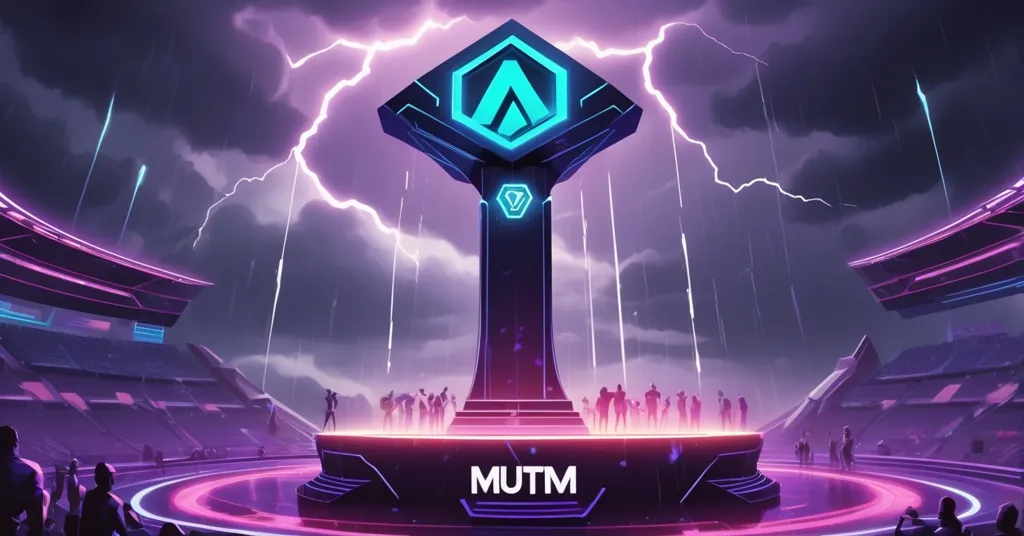Mutuum Finance Presale at $0.035: Can This DeFi Token Rival Solana’s Returns?

Mutuum Finance Presale at $0.035: Can This DeFi Token Outpace Solana?
A new DeFi contender, Mutuum Finance (MUTM), priced at just $0.035 during its presale, is generating serious buzz with claims it could deliver better returns than Solana (SOL), a major altcoin currently stumbling through price troubles. Is this the next big thing, or just another overhyped gamble in the crypto jungle?
- Mutuum Finance (MUTM) Hype: DeFi token at $0.035, raising $18.9 million from over 18,000 investors in presale.
- Price Projections: Expected to rise to $0.04 in Phase 7 and $0.06 on market listing.
- Solana’s Struggles: Risks dropping to $55-$85 if it can’t hold above $130.
- High Risk Warning: MUTM’s presale success doesn’t guarantee delivery—scams and failures are rampant in DeFi.
Mutuum Finance Presale: Numbers and Hype
Mutuum Finance is making waves in the decentralized finance (DeFi) space, pulling in a staggering $18.9 million from 18,140 investors during Phase 6 of its presale. Starting at a bargain-basement price in Phase 1, the MUTM token has already surged 250% to its current $0.035, with projections suggesting a bump to $0.04 in the upcoming Phase 7 and $0.06 once it lists on public exchanges. For speculators chasing the next moonshot, those numbers are like catnip—irresistible, yet potentially toxic. Mutuum positions itself as a fresh player in DeFi lending and borrowing, a sector promising to disrupt traditional finance by letting users lend or borrow crypto directly, no bank required. If you’re curious about its potential, check out more on this emerging DeFi token’s promise to outperform Solana.
What’s got tongues wagging beyond the raw numbers is MUTM’s gamification strategy. They’ve introduced a reward dashboard highlighting the top 50 token holders, turning investing into a competitive game. Think of it as a leaderboard where holding more tokens earns you bragging rights—and hopefully, loyalty to the project. It’s a psychological trick to fuel FOMO (fear of missing out), encouraging investors to buy more to climb the ranks. On the development side, Mutuum is in Phase 2 of its roadmap, focusing on smart contract infrastructure—basically, the automated code that powers their lending system—and a user-friendly DApp interface. They’re also activating their V1 Protocol, likely the first iteration of their platform for operational testing. If they deliver on these milestones, it’s a step forward. But let’s not kid ourselves—crypto roadmaps are often more fantasy than reality, and presale hype has left many investors holding empty bags.
For the uninitiated, DeFi refers to financial tools built on blockchain technology, aiming to cut out middlemen like banks. Smart contracts, which are self-executing agreements coded to handle transactions (like issuing a loan when collateral is locked), are the backbone of most DeFi projects. MUTM’s pitch isn’t groundbreaking—platforms like Aave and Compound have offered lending and borrowing for years. The real question is whether Mutuum can stand out with better rates, security, or usability, or if it’s just repackaging old ideas with a shiny presale bow.
Solana’s Price Woes: A Giant Stumbling
While Mutuum Finance basks in presale glory, Solana (SOL), once dubbed an “Ethereum killer” for its lightning-fast transactions and dirt-cheap fees, is hitting a rough patch. Hovering around $130 based on recent market data, SOL faces intense selling pressure. If it can’t hold above this critical price point—where buyers often step in to prevent further drops—analysts warn of a slide to as low as $55-$85. That’s a brutal hit for holders, especially given Solana’s history of network outages and congestion issues that have dented confidence over the years.
Solana is a layer-1 blockchain, meaning it’s a foundational network like Bitcoin or Ethereum, designed to host a vast ecosystem of applications from DeFi protocols to NFT marketplaces. Its total value locked (TVL) in DeFi—essentially the amount of crypto staked or used in its apps—still ranks it among the top chains, despite recent declines. But when the network glitches, as it has in the past with multi-hour downtimes, trust erodes, and prices often follow. Comparing a presale project like MUTM to an established player like Solana feels like sizing up a rookie against a seasoned pro. Sure, the rookie might have potential, but the pro has battle scars and a track record—flawed as it may be.
DeFi Trends in 2023: Context for the Hype
Zooming out, the DeFi landscape in 2023 offers a mixed bag. Total value locked across all DeFi protocols has dipped from its 2021 peaks, reflecting a cooling of the mania that fueled countless projects. Regulatory scrutiny is ramping up, with governments eyeing ways to clamp down on unverified platforms. Yet, adoption persists among those seeking alternatives to traditional finance, especially in regions with unstable currencies. Mutuum Finance enters this arena with big promises, echoing the early days of projects like Uniswap, which grew from a novel idea to a DeFi cornerstone. But for every Uniswap, there are dozens of failed ICOs and rug pulls—projects that raised millions only to disappear overnight. MUTM’s $18.9 million haul is impressive, but it’s no guarantee of longevity.
Solana, meanwhile, remains a key player despite its hiccups. Its ecosystem supports major DeFi apps and NFT platforms, even if network reliability remains a sore point. If SOL drops to $55, savvy investors might see it as a discount on a chain with proven utility, not a death sentence. The contrast with MUTM couldn’t be starker—one’s a gamble on a blueprint, the other a bet on a bruised but standing fighter.
Critical Reality Check: Hype vs. Hard Truths
I’m all for disruption and decentralization—Bitcoin is and always will be the gold standard for financial sovereignty and privacy. But I’m not blind to the gaps it leaves, which altcoins and DeFi experiments like Mutuum Finance could, if legit, address. Lending and borrowing done right could empower the unbanked and dismantle predatory systems. MUTM’s early traction is hard to ignore. Yet, let’s cut the crap: the crypto graveyard is overflowing with presale darlings that raised fortunes only to collapse into nothingness. Rug pulls, ghosted roadmaps, and sheer incompetence are par for the course. And those price predictions? Claiming MUTM “will” hit $0.06 or any number is either fortune-telling or straight-up shilling. In this game, the only sure thing is volatility.
Let’s play devil’s advocate with some hard questions. Who are these 18,000+ investors backing MUTM? Genuine believers, or just a handful of whales inflating the numbers with multiple wallets? A lack of transparency on their tech stack or security measures—like public audits or bug bounties—raises red flags in a space where trust is everything. And while gamification sounds cute, is a leaderboard really driving value, or just a cheap trick to keep the hype train chugging until listing day? Compare this to play-to-earn games, many of which used similar gimmicks only to crash when the novelty wore off. On the flip side, Solana’s current mess doesn’t erase its contributions to scalable blockchain tech. A drop to $55 might just be the dip before the rally—crypto loves a redemption arc as much as it loves a new toy.
Key Takeaways and Questions for Reflection
- What is Mutuum Finance (MUTM), and why is it trending?
MUTM is a DeFi token priced at $0.035 in presale, focused on lending and borrowing, gaining attention for raising $18.9 million from over 18,000 investors. - Can MUTM realistically outshine Solana (SOL) this cycle?
It’s a long shot—MUTM is an untested project banking on presale hype, while Solana, despite price woes, has a functioning ecosystem with real adoption. - What risks come with investing in a DeFi presale like MUTM?
Massive risks loom, including unproven technology, potential scams, and failure to deliver on promises, with many similar projects vanishing post-launch. - Are Solana’s troubles a permanent setback?
Unlikely—network issues and price drops hurt, but Solana’s role in DeFi and NFTs suggests it’s got fight left, especially if prices bottom out as a buying opportunity. - How should investors approach new DeFi tokens in 2023?
With extreme caution—scrutinize the team, whitepaper, and code audits before investing, as hype often overshadows fundamentals in this volatile space.
Mutuum Finance might look like a golden ticket at $0.035, but it’s a gamble wrapped in shiny marketing. I’m rooting for any project that challenges the financial status quo, but blind faith is a fast track to a wiped-out portfolio. Before tossing money at MUTM, dig into their team, tech, and roadmap—hype doesn’t equal results. As for Solana, its dip is a harsh reminder that even titans falter, but they often rise again. Stack your sats, do your own research, and remember: in crypto’s uncharted jungle, the only safe bet is the one you’ve vetted to death.
Note: Price projections for MUTM and SOL are purely speculative based on current market sentiment, not guarantees. Always do your own research before investing.



